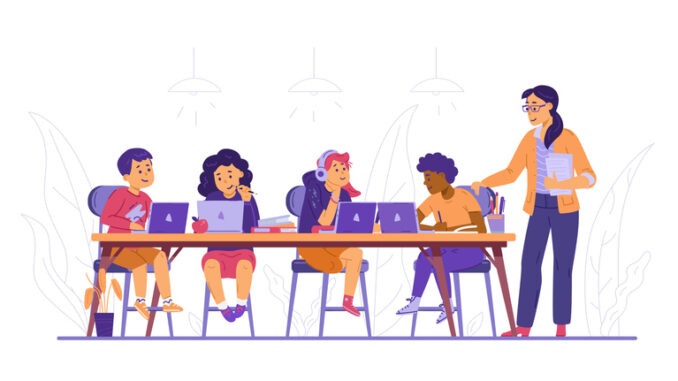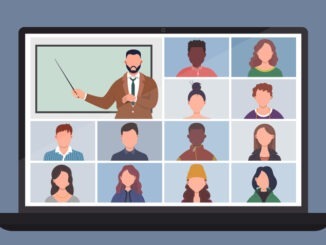
Sarah Evans and Fiona Aubrey-Smith believe we need to consider how we incorporate children’s knowledge and experience of technology into work in the classroom as effectively as possible
Read the full article below or read on page 32 in our September magazine
As a result of the pandemic the children in our classrooms today have an unprecedented level of experience in using technologies as part of their learning (APPG, 2021). As we all move forward from the pandemic, and find our own ‘new normal’ ways of working, one of the significant conversations has been about how to incorporate these experiences meaningfully into planning for today and tomorrow. As recently published by the DfE Education Technology Survey, a majority of schools are now working towards a 1:1 device approach (DfE, 2022). Different schools and groups are at varying stages of enabling this. The most common approaches are:
- Class-Based Device Access: schools have laptop trolleys in classes or year groups so that teachers can permit devices as part of classroom activities.
- Devices On Demand: schools provide devices in class that children can choose to access when it supports or enhances their learning.
- Targeted Provision of Devices: schools provide targeted children with a school-owned device (e.g. for particular year groups, or learning needs).
- Loaned Devices: schools loan a device to each child for the duration of the school year, or school career, that they can use both in class and at home.
- Bring Your Own Device: Children bring their own devices into school (BYOD) to enable fluid learningboth at home and at school.
- Bring Your Own/Loaned Device Mix: children bring their own devices into school and those unable to do so are loaned school devices – so that every child has access to their ‘own’ device both in class and at home.
A combination of children bringing their own devices from home and providing school-loaned devices for those unable to do so is, arguably, the most pragmatic and powerful. This is largely because it is the most cost and time-efficient way of ensuring every child has access to a device that they can call their own. From a pedagogical perspective, it is this sense of ownership that will bridge device usage from being a novelty to being transformational in terms of educational outcomes.
Drawing upon the research evidence, Twining and Maher (2017) found that when students were given the opportunity to choose when and where to use their devices they became more discerning about the technology’s use and its impact on their learning. In other words, they focused on what would help their learning (increasing metacognitive skills) rather than the novelty of using devices.
Furthermore, Liu et al. (2014) found that student access to 1:1 devices was attributed to a blurring of boundaries between ‘formal and informal learning space’ and extending learning from school into the home. Children at Sherborne House School very much reflect this:
- “I can have my own layouts on my screen. I can do my work more quickly because I know my own keyboard and shortcuts.”
- “I’ve used my own device for maths and English…I can leave tabs open from work I’ve done in class….and use it for homework too”
- “The good thing about using your own device is that access is quicker and you have your own home screen so you know where everything is.”
- “I like having the opportunity to choose to use my own computer to help me in my learning. It means I can choose how to present my work.”
Once children have the fluidity of access to a device that they can think of as their own, this opens up all kinds of creative opportunities to enhance teaching and learning purposefully. The necessary adaptation of lessons for online delivery during the pandemic has empowered teachers with a plethora of new skills – a very steep learning curve for many, but one which has had wide-reaching consequences. The way that learning takes place has changed rapidly, with staff and students readily tackling the complexities of working online, managing content in the cloud, collaborating on shared projects, engaging with interactive tools and embracing new presentation methods.
These kinds of approaches encourage the creation of a more engaging learning environment, with adaptations to suit different learning needs and opportunities to form connections and apply transferable skills. Embracing technology as a tool for students to use alongside other, more traditional, educational resources, reflects the way that they use technology at home, and is more representative of how they are likely to use technology in their future careers. Today’s young people are unafraid of technology and willing to explore its uses and limits in all aspects of their lives. Without embracing this in the school environment, we would be hampering a way of learning that is more natural to them than it is, perhaps, to their parents and teachers. Allowing our students to drive their learning through inquiry and research, with the use of the most up-to-date web content, fosters independent thinking skills and helps create more active and focused learning.
It is up to us as teachers to decide how we engage with, and embrace, these opportunities. Large-scale studies by Twining et al., (2017) found that the use of technologies amplifies the existing pedagogical stance of children’s teachers – in other words, technology highlights the way that we teach, and the types of learning experiences we provide for our children. Selwyn (2019), refers to the role of teachers as ‘pedagogical gatekeepers’ to student learning experiences – bringing to the fore our decisions about what we allow or encourage children to do using their devices as part of their learning.
At Sherborne House School we believe in using technology to make activities meaningful, engaging and personal for our children. For example, this term the children have used their own devices to engage interactively with live video lessons, re-watch teacher instruction at their own pace, research information as part of their learning projects, move through sequences of activities based on their individual attainment and confidence, choose platforms on which to publish their writing in a variety of different ways, create collaborative documents to co-construct work with other students and to drive their own progress through the use of adaptive online questions.
As highlighted in the Oxford University Press (2021) Addressing the Deepening Digital Divide report, if the digital divide is left unaddressed, the gap between the under-connected and the hyper-digitalised will widen, aggravating existing inequalities. So, the decisions we make are about more than just engaging children in their learning; they are fundamentally about social justice and equality – ensuring meaningful and purposeful learning for all students.
Cost-effective suggestions to facilitate every child having 1:1 device access
- Purchase low-cost devices (e.g. Chromebooks, starting from £109).
- Purchase reconditioned laptops from reputable organisations (e.g. 2econd chance – starting from £59).
- Repurpose old devices (e.g. install Chrome OS on old MacBooks/Windows laptops).
- Remove restrictions on where existing devices are being kept or stored so that they are more freely accessible to students as and when they need them.
- Accept donations of tablets and laptops.


Be the first to comment